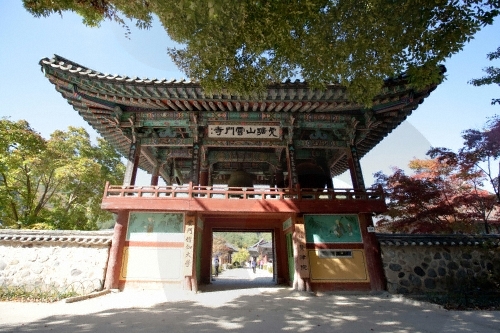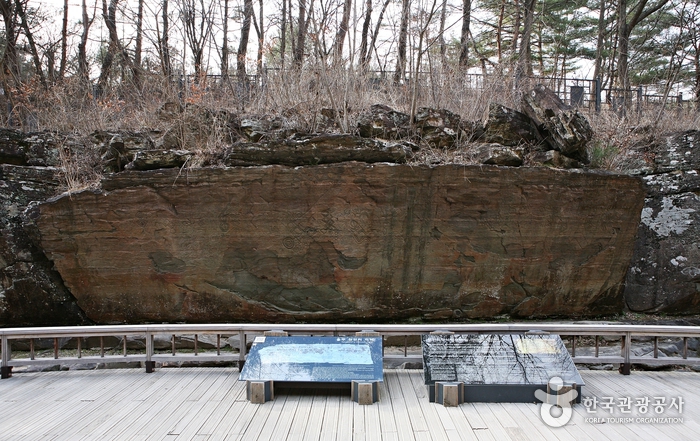Unmunsa Temple (운문사)
16.0 Km 17414 2021-07-21
264, Unmunsa-gil, Unmun-myeon, Cheongdo-gun, Gyeongsangbuk-do
+82-54-372-8800
Unmunsa Temple in Cheongdo, Gyeongsangbuk-do belongs to Cheongdo-gun in terms of administrative district. However, it is actually more closely connected to Daegu in terms of traffic and lifestyle. Unmunsa Temple was built in 560 during the Silla period. This ancient temple features seven treasured artifacts including the Weeping Pine Tree (Natural Monument No. 180) and stone lantern. There are four small hermitages (Sariam, Naewonam, Bukdaeam and Cheongsinam) around the temple. Moreover, the surrounding forest of pine and fir trees only enhances the temple’s beauty.
Unmunsa is the largest Buddhist nunnery in Korea, maintaining a capacity of roughly 260 bhikkhunis, or Buddhist nuns, who practice Buddhism in a four-year term. But, thanks to its magnificence and lush forest, Unmunsan Mountain, located on the southernmost part of Taebaek Mountain range, has become a favorite spot for many tourists.
Wondong Recreational Forest (원동자연휴양림)
16.2 Km 174466 2024-02-23
69 Neulbat-ro, Wondong-myeon, Yangsan-si, Gyeongsangnam-do
Wondong Recreational Forest is situated where Gajisan Mountain – often referred to as the Alps of Korea – meets Yeongchuksan Mountain. It is celebrated for its breathtaking landscape, which includes valleys, dense forests, and waterfalls. This forest provides an ideal setting for forest bathing, allowing visitors to immerse themselves in nature along the crystal-clear waters of the valley, surrounded by unique rock formations. Additionally, with the largest campground in Wondong, the Wondong Recreational Forest attracts numerous tourists seeking a serene camping experience amidst natural beauty.
Petroglyphs of Bangudae Terrace (울주 대곡리 반구대 암각화)
16.2 Km 26550 2023-07-17
285, Bangudaean-gil, Ulju-gun, Ulsan
+82-52-204-0322
In Daegok-ri, Eonyang-eup sits Bangudae Terrace, a picturesque spot where a ridge of Yeongosan Mountain extends to and stands tall to form quite a spectacle featuring uniquely shaped rocks and cliffs. The name, Bangudae, comes from how it resembles a turtle lying prone on the ground. Petroglyphs are paintings drawn by people from the prehistoric times carved on rocks and depicting various scenes and events in their daily lives. Petroglyphs were often drawn on enormous rocks and other sacred locations of groups, and it is believed that people gathered around them to hold various rituals.
Petroglyphs of Bangudae Terrace in Daegok-ri, Ulju-gun are estimated to have been drawn over several periods since the New Stone Age so you can discover the differences in styles among various ages. Primary objects that were popularly carved include sea animals, land animals, humans and tools and, as our prehistoric ancestors actively engaged in hunting, the hope of abundance in game is believed to be the reason why these objects were frequently carved on rocks. Vividly expressing animals and hunting scenes and colorfully depicting outstanding traits of objects, these petroglyphs are a form of both hunting art and religious art, and they are considered as the greatest masterpieces from which we can take a peek at the life and customs of the prehistoric ages.
Ulsan Daegok Museum (울산대곡박물관)
16.6 Km 38509 2021-05-18
257, Seohacheonjeon-ro, Ulju-gun, Ulsan
+82-52-229-4787
Ulsan Daegok Museum displays artifacts that were uncovered from the area of Daegok-ri during the construction of Daegok Dam. Approximately 13,000 relics were excavated during land inspection prior to the dam construction, including Hasamjeong Ancient Tomb. These findings were collected and became available for public display when the museum opened on June 24, 2009.
Petroglyphs of Cheonjeon-ri, Ulju (울주 천전리 각석)
16.9 Km 30009 2020-02-05
Cheonjeon-ri, Dudong-myeon, Ulju-gun, Ulsan
+82-52-277-0101
Petroglyphs refer to the paintings in which objects and symbols are carved, pecked, and colored on rocks, huge cliffs and cave walls.
Some of these rocky paintings are from as early as the late Paleolithic Era, but mostly they are seen from the New Stone Age, Neolithic Era and Bronze Age in which times these paintings were abundant.
The upper part of the rock shows various animals including deer pecked into the rock, and the lower part of the rock has writing and drawings of humans, and animals made by penciling.
As for the upper part, it is thought to have been made throughout the New Stone Age and Bronze Age to express their consciousness for abundance. In comparision, the painting of a cavalcade, a sailing boat, a dragon, a horse, and a deer and about 300 writings on the lower part of the rock were considered to be done by people during unified Silla, showing their belief of the area as a holy ground.
Maneosa Temple (만어사)
17.6 Km 30318 2024-02-23
776 Maneo-ro, Samnangjin-eup, Miryang-si, Gyeongsangnam-do
Maneosa Temple, perched on Maneosan Mountain in Miryang, dates back to 46 A.D. and is steeped in tradition and numerous legends. During the Silla dynasty, it served as a ceremonial site for the king to conduct Buddhist rites. Notably, beneath the Mireukjeon Hall lies the Maneoseok Rocks, reputed to be fish that transformed into stones. Remarkably, these stones emit a clear, bell-like sound when struck, earning them the nickname Jongseok (Bell stone). The temple also features a three-story stone pagoda, standing 3.7 meters tall, which has been designated as a Treasure.
Lotte Mart [Tax Refund Shop] (롯데마트)
17.9 Km 0 2024-04-23
34, Samho 1-gil, Yangsan-si, Gyeongsangnam-do
-
Yangsan Museum (양산시립박물관)
18.7 Km 4107 2021-08-05
78, Bukjeong-ro, Yangsan-si, Gyeongsangnam-do
+82-55-392-3314
Yangsan Museum opened April 11, 2013 to preserve and study excavated cultural items from the Yangsan area, as well to act as an educational and cultural content space.
The design of the museum resembles the dolmen in Singi-dong and curved lines seen on the eaves of Tongdosa Temple’s Daeungjeon Hall, while the rotunda in the middle of the museum visualizes the old fire beacon on Wonjeoksan Mountain.
Yangsan Museum is comprised of five floors presenting the history and culture of Yangsan. The main exhibition hall is divided into a History Hall, Ancient Hall, Children's Historical Experience Hall, Special Exhibition Hall, and 3D Visual Hall. As the exhibition halls are divided by theme and period, the flow of the museum allows you to easily absorb the information on display. Not only does the museum display relics, but also models, dioramas and a variety of footage is on display, presenting the past, present, and future crossing over in one space to give visitors a nice sense of realism as they tour the facility.
Uniqlo - Yangsan Branch [Tax Refund Shop] (유니클로 양산)
19.3 Km 0 2024-04-17
921, Yangsan-daero, Yangsan-si, Gyeongsangnam-do
-
LG Best Shop - Yangsan Bukjeong Branch [Tax Refund Shop] (엘지베스트샵 양산북정점)
19.3 Km 0 2024-04-19
915, Yangsan-daero, Yangsan-si, Gyeongsangnam-do
-



![Lotte Mart [Tax Refund Shop] (롯데마트)](http://tong.visitkorea.or.kr/cms/resource/29/2891029_image2_1.jpg)
![Uniqlo - Yangsan Branch [Tax Refund Shop] (유니클로 양산)](http://tong.visitkorea.or.kr/cms/resource/11/2888311_image2_1.jpg)
![LG Best Shop - Yangsan Bukjeong Branch [Tax Refund Shop] (엘지베스트샵 양산북정점)](http://tong.visitkorea.or.kr/cms/resource/82/2890282_image2_1.jpg)
 English
English
 한국어
한국어 日本語
日本語 中文(简体)
中文(简体) Deutsch
Deutsch Français
Français Español
Español Русский
Русский